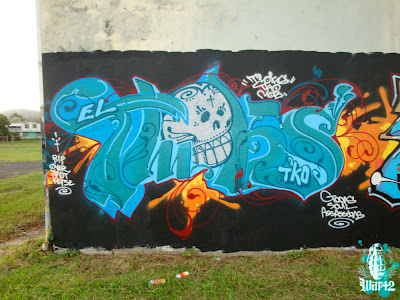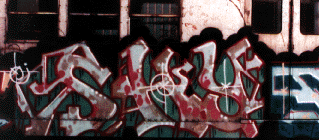
Born in Ponce, Puerto Rico in 1960, Quinones was raised in New York’s Lower East Side. Lee Quinones is considered the single most influential artist to emerge from the New York City subway art movement. He is a celebrated figure in both the contemporary art world and in popular culture circles, faithfully producing work that is ripe with provocative socio-political content and intricate composition. Lee’s paintings are housed in the permanent collections of the Whitney Museum of Art, the Museum of the City New York, the Groninger Museum (Groningen, Netherlands) and the Museum Boijmans Van Beuningen (Rotterdam, Netherlands, and have been exhibited at the New Museum Of Contemporary Art (New York City), the Museum of National Monuments (Paris, France) and the Staatliche Museum (Germany). Quinones was raised in New York’s Lower East Side in a family that kept close ties to their cultural heritage surrounded by a predominantly Nuyorican community. By age 5, Lee showed a penchant for drawing,




Lee painted his first subway piece in 1974. Inspired by the leading figures of subway lore including Cliff 159 of the 3-Yard Boys, and Blade One of the Crazy 5, Lee began creating whole 40-foot subway car murals in late 1975. By 1976, Lee was a shadowy legend, leaving his fervent mark in a voracious whole subway car campaign strewn across the #5 IRT. Over the next decade he would paint an estimated 115 whole subway cars throughout the MTA system. In late 1975, Lee was asked to join the Fabulous Five, an elite quintet of seemingly mythic graffiti writers. The Fabulous Five’s greatest feat — the only running 10-car train painted from top to bottom, end to end — made its legendary journey in November 1976. Lee was instrumental in moving enamellist art above ground when he stealthily painted “Howard the Duck,” the first entire 25 x 30 foot handball court mural, in the spring of 1978 outside of his Corlears Junior High School #56. “There are people who see the graffiti experience as a vocation of adolescence, the rites of passage without a sense of direction,” says Lee. “I’m not surviving by offending it or defending it, but I saw it early on as a catalyst to develop as a painter and explore the other horizons outside of a forty foot subway car.

My sense of art was to create art without a reference point to art history, because this was art history in the making. A true art movement never goes by the script, instead it flips the script, faithfully reinventing itself.”Lee had his first solo exhibition at Claudio Bruni’s Galleria La Medusa in Rome, Italy late in 1979, which was also the first international show to feature graffiti-based art. One year later, Lee made his New York gallery debut with “The Third Phase” at the White Columns Gallery, ushering in an era as spray paint made the transition from moving objects to stationery canvas. That same year, he was part of the seminal Times Square show held in an abandoned massage parlor that highlighted the post-modernist masters of the day,including Jenny Holzer, Keith Haring, Kiki Smith, Jane Dickson, and Jean Michel Basquiat. Subsequent shows including the Graffiti Art Success for America at Fashion Moda in 1980 and the New York/ New Wave show in 1981 at PS1 Moma were also instrumental in introducing his work to the watchful art world. Lee’s international prominence led to celebrated solo shows such as “Rusto-LEE-Um” at the Fun Gallery and exhibits at Barbara Gladstone, Sidney Janis, Riverside Studios and the Zwirner Gallery. His paintings were included in the prestigious 1983 Documenta #7 held in Kassel, Germany. As his work gained widespread exposure, Lee found himself at the cross-section of two movements in their infancy- hip-hop and punk rock, which provided context for the direction of his work.


Much of this influence was due to Fred Brathwaite who sought out Lee in 1979. Lee credits Brathwaite - known as Fab Five Freddy- for single-handedly fusing uptown hip-hop flavor with the gritty downtown punk aesthetic.Lee starred in director Charlie Ahearn’s Wild Style, a film loosely written about Lee’s life, endearing him to a generation of hip-hop fans that premiered in 1983. His work also appeared in Tony Silvers and Henry Chalfant’s 1983 documentary film Style Wars. The art and music of the time further meshed as Lee, Fab Five Freddy and Jean Michel Basquiat designed backdrops for Blondie’s infamous “Rapture” video. Lee continued to work behind the scenes on film projects including Susan Seidelman’s Smithereens (1982) and Desperately Seeking Susan (1985) creating an alternate format that broadened his perception through the lens of the camera. He has also worked on films with Lawrence Fishburne, Rosie Perez and Fred Durst. Lee’s body of work extends across a massive scope – from canvas to large murals and installation to elaborate commissions. His collaborations with companies include a 25th anniversary edition of the Adidas shoe as part of a series including the Red Hot Chili Peppers and Missy Elliott, of which his edition sold out worldwide in half a day. He has also worked with Ford Motor Company, Nike, IFC TV, Viacom, Absolute Vodka, and Automobile Magazine among others.


Lee has lectured at universities and cultural institutions including New York University, Columbia University, the University of New Mexico, the Rock & Roll Hall of Fame, and the Institute of North American Studies in Barcelona, Spain. Lee has twice beenrecognized at the VH1 Hip-Hop Honors awards show and he was a recipient of the Jam Master Jay Award for the Arts in 2007. In the aftermath of Hurricane Katrina, he raised $65,000 for the Boys and Girl’s Clubs of America by riding a bicycle from New York to Miami. For his humanitarian efforts, October 27th is officially Lee Quinones Day in New York, an honored bestowed by both Manhattan and Brooklyn borough presidents. While the nature of Lee’s work continues to evolve, his artistic identity remains rooted in principle and adherence to highly detailed, composition that defined his work on the subways. Art critic Carlo McCormick writes “While much of his current oeuvre continues to embody the energy and movement that typified his early work, it is formally much more complex. Quinones’ art has essentially been a search for a greater metaphor than for mere topicality. His trains of the past, along with the murals and canvases of today have consistently distilled his introspective journey into self-awareness within broader, universal themes. His personal experience, the consciousness of who he is and what he feels, is but a jumping point to an epic accessible language and spatially allegorical narratives. In the technological age whose cyber-arena is the basis of information exchange, Lee is ever conscious of the heroic and mythic dimension of the street. His vision is a continuum of romantic rebelliousness.”




































.jpg)
.jpg)
.jpg)













